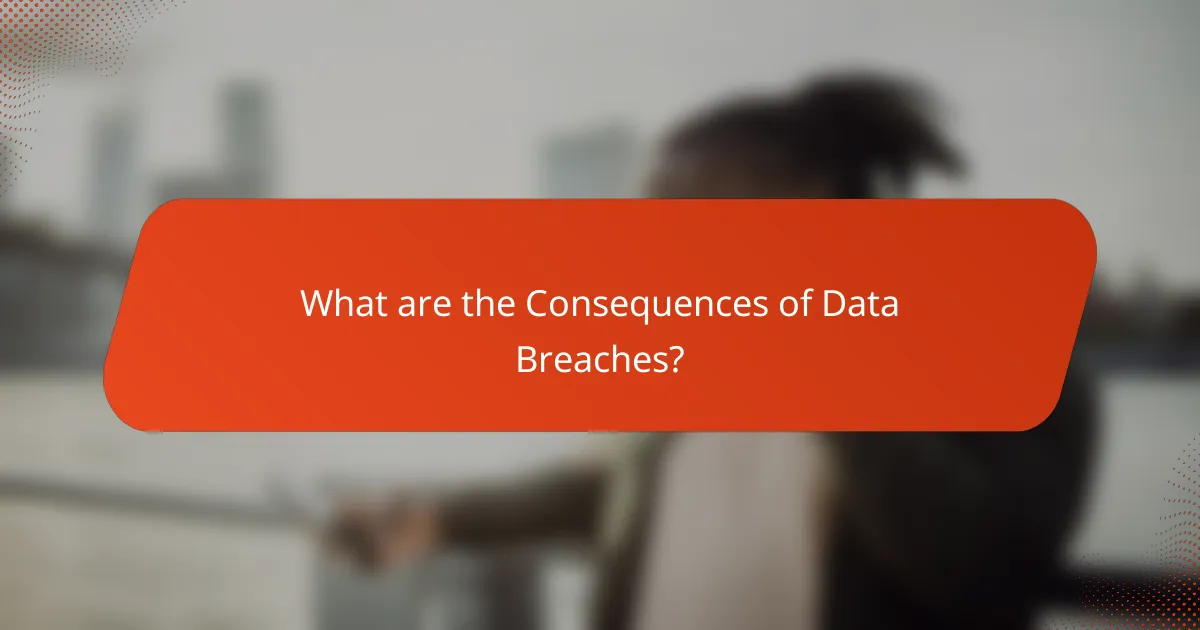Data breaches are incidents where unauthorized individuals access sensitive data, including personal information and financial records, leading to serious consequences such as identity theft and reputational damage for organizations. In 2020, over 1,000 data breaches were reported, affecting millions and highlighting the importance of cybersecurity measures. The causes of data breaches include human error, cyberattacks, and system vulnerabilities, with human error accounting for a significant portion. Financial losses from breaches can average around $4.45 million, along with potential legal penalties and diminished customer trust. This article analyzes the causes, consequences, and prevention measures related to data breaches, emphasizing the need for robust security practices and employee training.

What are Data Breaches and Why Do They Matter?
Data breaches are incidents where unauthorized individuals gain access to sensitive data. This can include personal information, financial records, or confidential business data. Data breaches matter because they can lead to identity theft, financial loss, and damage to an organization’s reputation. According to the Identity Theft Resource Center, over 1,000 data breaches were reported in 2020 alone, affecting millions of individuals. Organizations may face legal penalties and increased scrutiny following a breach. Protecting data is crucial for maintaining trust and ensuring compliance with regulations like GDPR. Data breaches highlight the importance of cybersecurity measures and employee training.
What are the common types of data breaches?
Common types of data breaches include hacking, phishing, insider threats, and physical theft. Hacking involves unauthorized access to systems, often exploiting vulnerabilities. Phishing is a method where attackers trick individuals into revealing sensitive information. Insider threats occur when employees misuse their access to data for malicious purposes. Physical theft involves stealing devices containing sensitive information. According to the Verizon Data Breach Investigations Report, hacking is the most common cause of data breaches, accounting for 81% of incidents in 2020.
How do external threats contribute to data breaches?
External threats significantly contribute to data breaches by exploiting vulnerabilities in systems. Cybercriminals often use methods like phishing, malware, and ransomware to gain unauthorized access. According to the 2021 Verizon Data Breach Investigations Report, 85% of breaches involved a human element, highlighting the role of social engineering. Additionally, unpatched software and weak passwords create openings for attackers. In 2020, the average cost of a data breach was $3.86 million, underscoring the financial impact of these external threats. Furthermore, advanced persistent threats (APTs) can target organizations over extended periods, increasing the likelihood of a successful breach.
What role do internal threats play in data breaches?
Internal threats significantly contribute to data breaches. Employees or insiders often have access to sensitive information. This access can lead to accidental or intentional data exposure. According to the 2021 Verizon Data Breach Investigations Report, 22% of data breaches involved internal actors. Insider threats can stem from negligence, such as mishandling data. They can also arise from malicious intent, such as data theft. Organizations must implement strict access controls and monitoring. Regular training can help mitigate these risks.
Why is understanding data breaches important for organizations?
Understanding data breaches is crucial for organizations to protect sensitive information. Data breaches can lead to significant financial losses, with the average cost per breach reaching $3.86 million in 2020 according to IBM. Organizations must recognize the potential damage to their reputation, as 75% of consumers may stop purchasing from a brand after a breach. Compliance with regulations, such as GDPR, requires organizations to understand data breaches to avoid hefty fines. Furthermore, proactive measures can reduce the likelihood of breaches; companies that invest in cybersecurity can save up to $1.4 million per incident. Understanding data breaches ultimately enables organizations to enhance their security posture and safeguard their assets.
How can data breaches impact an organization’s reputation?
Data breaches can severely damage an organization’s reputation. When sensitive information is compromised, trust erodes among customers and stakeholders. Surveys indicate that 75% of consumers would stop purchasing from a brand after a data breach. Furthermore, organizations may face negative media coverage that amplifies public perception issues. The fallout often leads to a decline in customer loyalty and market share. In some cases, organizations experience long-term financial impacts due to reputational damage. A study by IBM found that the average cost of a data breach is $4.24 million, which includes reputational harm. Overall, the repercussions of a data breach extend beyond immediate security concerns, affecting an organization’s standing in the marketplace.
What are the financial implications of data breaches?
Data breaches have significant financial implications for organizations. The immediate costs include legal fees, regulatory fines, and expenses related to incident response. According to the 2023 Cost of a Data Breach Report by IBM, the average total cost of a data breach is $4.45 million. This figure reflects both direct and indirect costs associated with a breach.
Long-term implications can include loss of customer trust and brand reputation. A study by PwC found that 87% of consumers will not do business with a company after a data breach. Additionally, companies may face increased cybersecurity insurance premiums and ongoing monitoring costs.
Overall, the financial impact of data breaches extends beyond immediate expenses, affecting revenue and operational efficiency in the long run.

What are the Causes of Data Breaches?
Data breaches are caused by various factors, including human error, cyberattacks, and system vulnerabilities. Human error accounts for a significant portion of data breaches. This includes mistakes like sending sensitive information to the wrong recipient or failing to secure devices. Cyberattacks, such as phishing and malware, are increasingly common. These attacks exploit weaknesses in security protocols. Additionally, system vulnerabilities arise from outdated software or misconfigured systems. According to a 2020 report by IBM, human error was involved in 23% of data breaches. The same report indicated that cyberattacks are responsible for a growing number of incidents, highlighting the importance of robust security measures.
What are the primary factors leading to data breaches?
The primary factors leading to data breaches include human error, inadequate security measures, and malicious attacks. Human error accounts for a significant percentage of breaches. Employees may inadvertently expose sensitive data through phishing or misconfigurations. Inadequate security measures often leave systems vulnerable. Organizations that fail to implement strong encryption or access controls are at higher risk. Malicious attacks, such as ransomware or hacking, also contribute to data breaches. Cybercriminals exploit vulnerabilities in software and systems to gain unauthorized access. According to the 2021 Verizon Data Breach Investigations Report, 85% of breaches involved a human element. Therefore, addressing these factors is crucial for enhancing data security.
How does human error contribute to data breaches?
Human error significantly contributes to data breaches by creating vulnerabilities in security protocols. Common mistakes include weak password management, such as using easily guessable passwords. Phishing attacks often succeed due to employees clicking on malicious links. Misconfigured security settings can expose sensitive data unintentionally. According to a 2020 report by IBM, human error accounted for 95% of cybersecurity incidents. Training and awareness programs can reduce these risks significantly. However, without proper education, employees remain susceptible to making critical errors.
What technological vulnerabilities can lead to data breaches?
Technological vulnerabilities that can lead to data breaches include software flaws, outdated systems, and weak passwords. Software flaws can be exploited by attackers to gain unauthorized access. Outdated systems often lack the latest security patches, making them susceptible to known vulnerabilities. Weak passwords can be easily guessed or cracked, allowing intruders to access sensitive information. Additionally, misconfigured security settings can expose data unintentionally. According to the Verizon Data Breach Investigations Report, 81% of hacking-related breaches involved stolen or weak passwords.
How do organizational practices influence data breach occurrences?
Organizational practices significantly influence the frequency of data breaches. Effective security protocols, employee training, and risk management strategies reduce vulnerabilities. For instance, organizations with regular security training for employees see fewer breaches. According to the Verizon Data Breach Investigations Report, human error is a factor in 22% of breaches. Additionally, organizations that implement robust access controls limit unauthorized data access. A study by IBM found that 95% of cybersecurity incidents are caused by human error. Thus, strong organizational practices create a proactive security culture, leading to fewer data breach occurrences.
What role does employee training play in preventing data breaches?
Employee training plays a critical role in preventing data breaches. It equips staff with knowledge about security protocols and potential threats. Well-trained employees are less likely to fall victim to phishing attacks. According to a report by the Ponemon Institute, human error accounts for 23% of data breaches. Regular training sessions reinforce best practices for data handling. This ongoing education helps create a culture of security awareness. Employees become more vigilant and proactive in identifying risks. Therefore, effective training significantly reduces the likelihood of breaches occurring.
How can inadequate security measures lead to data breaches?
Inadequate security measures can lead to data breaches by failing to protect sensitive information. Weak passwords can be easily guessed or cracked by attackers. Lack of encryption allows data to be intercepted during transmission. Insufficient access controls enable unauthorized users to access confidential data. Outdated software often contains vulnerabilities that can be exploited. Poor employee training can lead to phishing attacks, compromising security. According to the 2020 Verizon Data Breach Investigations Report, 22% of data breaches involved human error. Each of these factors increases the likelihood of a successful data breach.

What are the Consequences of Data Breaches?
Data breaches lead to significant financial losses and reputational damage for organizations. According to the IBM Cost of a Data Breach Report 2023, the average cost of a data breach is $4.45 million. Organizations may face legal consequences, including lawsuits and regulatory fines, which can further escalate costs. Customer trust often diminishes after a breach, resulting in decreased sales and customer retention. Additionally, breaches can lead to operational disruptions, hindering business continuity. Companies may also incur expenses related to incident response and remediation efforts. The long-term consequences include increased cybersecurity insurance premiums and ongoing scrutiny from regulators. In summary, data breaches have wide-ranging and severe impacts on organizations.
What are the immediate effects of a data breach on an organization?
A data breach immediately impacts an organization by compromising sensitive information. This can lead to financial losses due to fraud or theft. Affected organizations may face regulatory fines and legal actions. Additionally, customer trust is often severely damaged. The organization may experience reputational harm that affects future business. Operational disruptions can occur as IT teams respond to the breach. Data breaches can also result in increased cybersecurity costs. According to the IBM Cost of a Data Breach Report 2023, the average cost of a data breach is $4.45 million, highlighting the financial impact.
How can customer trust be affected by a data breach?
A data breach can significantly erode customer trust. Customers expect their personal information to be secure. When a breach occurs, it exposes sensitive data, leading to feelings of vulnerability. A study by the Ponemon Institute found that 75% of consumers would stop using a brand after a data breach. This statistic highlights the direct impact on customer loyalty. Additionally, companies may face reputational damage that lasts long after the incident. Trust is difficult to rebuild once it is lost. Customers may become more cautious and skeptical of future interactions with the brand. This shift can lead to decreased sales and long-term financial repercussions for the company.
What are the legal implications following a data breach?
Legal implications following a data breach include potential fines, lawsuits, and regulatory scrutiny. Organizations may face penalties under data protection laws like GDPR, which can impose fines up to 4% of annual global revenue. Affected individuals can file lawsuits for damages resulting from the breach. Companies are also required to notify affected parties and regulatory bodies within a specific timeframe, usually 72 hours under GDPR. Failure to comply with these obligations can lead to additional legal consequences. Public trust may diminish, impacting future business operations. Maintaining compliance with legal standards is crucial to mitigate these risks.
What long-term consequences can arise from data breaches?
Long-term consequences of data breaches include financial losses, reputational damage, and legal repercussions. Financial losses can arise from direct costs, such as remediation efforts, and indirect costs, including lost business. A study by IBM found that the average cost of a data breach is $3.86 million. Reputational damage can lead to a loss of customer trust. This can result in decreased sales and long-term customer relationships being affected. Legal repercussions may include lawsuits and regulatory fines. For example, companies may face penalties under regulations like GDPR, which can reach up to 4% of annual global revenue. Additionally, organizations may experience increased scrutiny from regulators and stakeholders. These consequences can persist for years, affecting the organization’s overall stability and growth.
How do data breaches influence market competitiveness?
Data breaches negatively influence market competitiveness by eroding consumer trust. Companies that experience breaches often face reputational damage. This leads to a decline in customer loyalty and sales. Competitors may capitalize on this opportunity to attract affected customers. Additionally, companies may incur significant financial losses due to legal fees and regulatory fines. For instance, the IBM Cost of a Data Breach Report 2021 states that the average cost of a data breach is $4.24 million. Such financial burdens can hinder investment in innovation and growth. Consequently, the overall market landscape can shift, favoring companies with stronger security measures.
What are the potential costs associated with recovery from a data breach?
The potential costs associated with recovery from a data breach can be substantial. Organizations may incur direct costs such as forensic investigation fees, which can average around $200,000. Legal fees for compliance and litigation can add another $100,000 or more. Notification costs to inform affected customers typically range from $1 to $3 per individual, depending on the scale of the breach. Additionally, there are costs related to public relations efforts to manage reputation damage, which can exceed $50,000.
Furthermore, businesses may face regulatory fines, which can vary widely but can reach millions depending on the severity of the breach and jurisdiction. The loss of customer trust can lead to decreased revenue, with studies indicating that companies can lose up to 20% of their customers after a breach. Overall, the total cost of recovery from a data breach can easily exceed $1 million, depending on the size and impact of the incident.
How can organizations mitigate risks associated with data breaches?
Organizations can mitigate risks associated with data breaches by implementing robust cybersecurity measures. This includes using firewalls, intrusion detection systems, and encryption technologies. Regularly updating software and systems helps close vulnerabilities. Employee training on security best practices reduces human error. Conducting regular security audits identifies potential weaknesses. Developing an incident response plan prepares organizations for breaches. Compliance with regulations like GDPR and HIPAA ensures adherence to security standards. According to the 2021 IBM Cost of a Data Breach Report, organizations with an incident response team saved an average of $2 million in breach costs.
What best practices should organizations implement for data protection?
Organizations should implement encryption, access controls, and regular security audits for data protection. Encryption secures sensitive data both at rest and in transit. Access controls limit data access to authorized personnel only. Regular security audits identify vulnerabilities and ensure compliance with data protection regulations. Employee training on data security best practices is essential to prevent human error. Implementing multi-factor authentication adds an extra layer of security. Monitoring and logging access to sensitive data helps detect unauthorized activities. These practices collectively reduce the risk of data breaches and enhance overall data security.
How can regular security audits help in preventing data breaches?
Regular security audits help prevent data breaches by identifying vulnerabilities in systems. These audits assess security controls and compliance with established policies. They uncover weaknesses that could be exploited by attackers. Regular reviews ensure that security measures are up-to-date. Organizations can implement necessary fixes before breaches occur. According to a 2021 report by IBM, organizations that conduct regular audits reduce the risk of data breaches by 50%. This proactive approach strengthens the overall security posture.
What practical steps can be taken to prevent data breaches?
Implementing strong security measures can prevent data breaches. Organizations should enforce strong password policies. Passwords must be complex and changed regularly. Multi-factor authentication adds an extra layer of security. Regular software updates fix vulnerabilities. Firewalls and antivirus software protect against threats. Employee training on security best practices is essential. Data encryption safeguards sensitive information. Regular security audits identify potential weaknesses. These steps collectively reduce the risk of data breaches significantly.
How can organizations enhance employee awareness regarding data security?
Organizations can enhance employee awareness regarding data security through comprehensive training programs. These programs should include regular workshops that cover the latest threats and best practices. Interactive sessions can engage employees and reinforce learning. Additionally, organizations should implement simulated phishing attacks to test employee responses. Providing clear guidelines on data handling can further clarify expectations. Regular updates about security policies keep employees informed of changes. Leadership should actively promote a culture of security awareness. Studies show that organizations with ongoing training reduce security incidents by up to 70%.
What technologies can be employed to safeguard against data breaches?
Encryption technologies can be employed to safeguard against data breaches. Encryption protects sensitive data by converting it into an unreadable format. Only authorized users with the correct decryption key can access the original data. This method significantly reduces the risk of unauthorized access. Additionally, firewalls act as barriers between trusted internal networks and untrusted external networks. They monitor and control incoming and outgoing network traffic based on predetermined security rules. Intrusion detection systems (IDS) also enhance security. IDS monitor network traffic for suspicious activity and alert administrators to potential threats. Multi-factor authentication (MFA) adds an extra layer of security. MFA requires users to provide two or more verification factors to gain access to resources. Regular software updates and patch management are crucial. They fix vulnerabilities that could be exploited by attackers. Implementing these technologies can effectively minimize the risk of data breaches.
Data breaches refer to incidents where unauthorized individuals access sensitive data, including personal and financial information. This article analyzes the causes of data breaches, which include human error, cyberattacks, and inadequate security measures, while also highlighting their significant financial and reputational consequences for organizations. Key topics include the types of data breaches, the role of external and internal threats, and the importance of employee training and robust cybersecurity practices in prevention. Additionally, the article discusses the long-term impacts of data breaches on market competitiveness and provides practical steps organizations can take to mitigate risks and enhance data protection.



